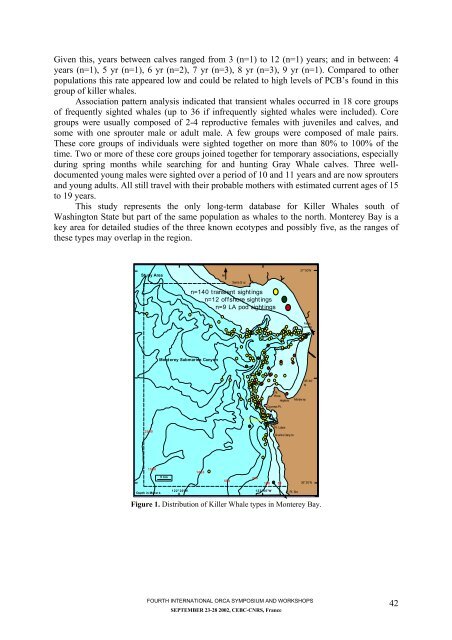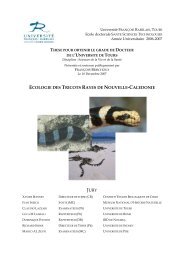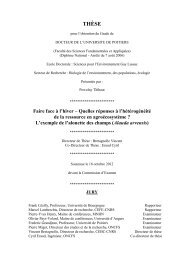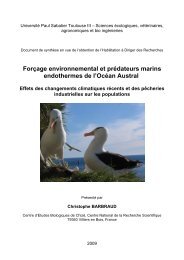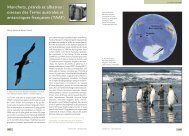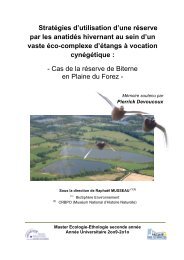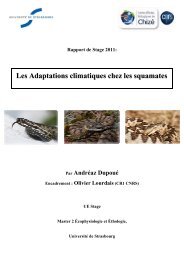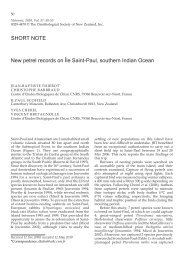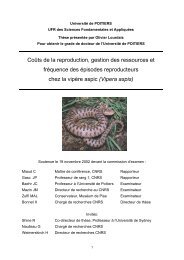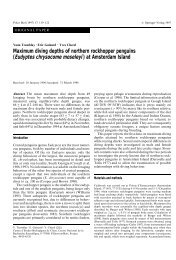Fourth International Orca Symposium and Workshop - CEBC - CNRS
Fourth International Orca Symposium and Workshop - CEBC - CNRS
Fourth International Orca Symposium and Workshop - CEBC - CNRS
Create successful ePaper yourself
Turn your PDF publications into a flip-book with our unique Google optimized e-Paper software.
Given this, years between calves ranged from 3 (n=1) to 12 (n=1) years; <strong>and</strong> in between: 4<br />
years (n=1), 5 yr (n=1), 6 yr (n=2), 7 yr (n=3), 8 yr (n=3), 9 yr (n=1). Compared to other<br />
populations this rate appeared low <strong>and</strong> could be related to high levels of PCB’s found in this<br />
group of killer whales.<br />
Association pattern analysis indicated that transient whales occurred in 18 core groups<br />
of frequently sighted whales (up to 36 if infrequently sighted whales were included). Core<br />
groups were usually composed of 2-4 reproductive females with juveniles <strong>and</strong> calves, <strong>and</strong><br />
some with one sprouter male or adult male. A few groups were composed of male pairs.<br />
These core groups of individuals were sighted together on more than 80% to 100% of the<br />
time. Two or more of these core groups joined together for temporary associations, especially<br />
during spring months while searching for <strong>and</strong> hunting Gray Whale calves. Three welldocumented<br />
young males were sighted over a period of 10 <strong>and</strong> 11 years <strong>and</strong> are now sprouters<br />
<strong>and</strong> young adults. All still travel with their probable mothers with estimated current ages of 15<br />
to 19 years.<br />
This study represents the only long-term database for Killer Whales south of<br />
Washington State but part of the same population as whales to the north. Monterey Bay is a<br />
key area for detailed studies of the three known ecotypes <strong>and</strong> possibly five, as the ranges of<br />
these types may overlap in the region.<br />
Study Area<br />
2000<br />
1500<br />
Depth in Meters<br />
Mont erey Submarine Canyon<br />
5 km<br />
Santa Cr uz<br />
Car mel Cany on<br />
122°20'W 122°00'W<br />
N<br />
n=140 transient sightings<br />
n=12 offshore sightings<br />
n=9 LA pod sightings<br />
1000<br />
500<br />
200<br />
Pt.<br />
Pinos<br />
Hopkins<br />
Cypr ess Pt.<br />
Pt. Lobos<br />
100 50<br />
Gr anite Canyon<br />
Pt. Sur<br />
37°00'N<br />
Monter ey<br />
Moss<br />
L<strong>and</strong>ing<br />
36°40'<br />
N<br />
36°20'N<br />
Figure 1. Distribution of Killer Whale types in Monterey Bay.<br />
FOURTH INTERNATIONAL ORCA SYMPOSIUM AND WORKSHOPS<br />
SEPTEMBER 23-28 2002, <strong>CEBC</strong>-<strong>CNRS</strong>, France<br />
42


